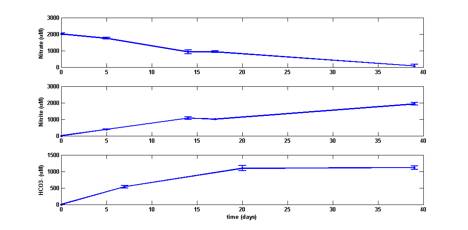AmericanChemicalSociety.com
Reports: AC2 48445-AC2: Microbial Biogeochemistry of Isoprenoid Hydrocarbon Cycling
Jennifer L. Macalady, Pennsylvania State University
Isoprenoid compounds, polymers of the 5-carbon hydrocarbon isoprene, are biosynthesized by organisms across the three domains of life. Enhanced stability, particularly in anoxic settings, is conferred by methyl branching of the alkyl chains. Long term preservation makes isprenoids useful geologic biomarkers with both taxonomic and paleoenvironmental specificity. For example, glycerol diether glycerol tetraethers (GDGT's) are indicative of archaea and show a relation to temperature, salinity and nutrient concentrations (Wuchter et al. 2006, Turich et al. 2007. Evidence exists for a microbial role in the anaerobic breakdown of isoprenoids through simultaneous changes in hydrocarbon profiles, gas evolution and electron acceptor concentrations, particularly in oil reservoirs. However, no information on the phylogeny and biochemistry of microorganisms carrying out this process has been reported (Bregnard et al. 1997, Grossi et al. 2000).
Previous work resulted in microcosms capable of the anaerobic degradation of both pristane and archaeal diphytanyl glycerol diether lipids (DGD's). Experiments in progress are designed to establish reaction stoichiometries and to monitor intermediates that may yield insight into the degradation pathway. In order to improve our estimates of the reaction stoichiometry, definitively identify metabolites and propose a degradation mechanism, we generated a 13C labeled substrate. Haloferax sulfurifontis, a halophilic archaeon, produces C20-C20 diether membrane lipids. After growth on 13C glucose, these lipids were extracted and converted to isoprenoid hydrocarbons. We are continuing this experiment using stable isotope probing to follow the incorporation of our labeled substrate into phytane degradation products and to identify the anaerobic isoprenoid degrader in our microcosm.
Figure 1: Synthesis of 13C labeled phytane from the DGD lipids of Haloferax sulfurifontis.
Figure 2: Nitrate consumption (top) acompanied by nitrite (middle) and bicarbonate (bottom) production in denitrifying, pristane degrading enrichments.
References
Bregnard, T. P., A. Haner, et al. (1997). "Anaerobic Degradation of Pristane in Nitrate-Reducing Microcosms and Enrichment Cultures." Appl. Environ. Microbiol. 63(5): 2077-2081.
Grossi, V., D. Raphel, et al. (2000). "Anaerobic biodegradation of pristane by a marine sedimentary bacterial and/or archaeal community." Organic Geochemistry 31(7-8): 769.
Turich, C., K. H. Freeman, et al. (2007). "Lipids of marine Archaea: Patterns and provenance in the water-column and sediments." Geochimica et Cosmochimica Acta 71(13): 3272-3291.
Wuchter, C., S. Schouten, et al. (2006). "Archaeal tetraether membrane lipid fluxes in the northeastern Pacific and the Arabian Sea: implications for TEX86 paleothermometry." Paleoceanography 21.
Copyright © American Chemical Society



